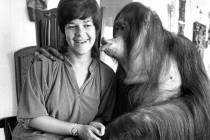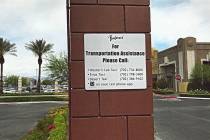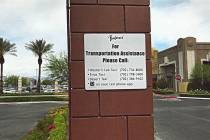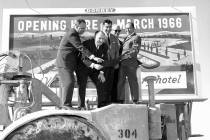Historic MGM property’s amenities include ghost, safe, profits
Railroad Pass hotel-casino will never be considered the flagship of the MGM Resorts International. Did you even know MGM owned the small casino between Las Vegas and Boulder City?
However, the casino staked its place in Nevada’s history: It’s the oldest existing licensed casino in Nevada, holding gaming license No. 4.
Nevada’s first gaming license wasn’t given to anyone, the second and third licenses have expired, and the fourth went to the Railroad Pass Club, now on the verge of celebrating its 80th anniversary on Aug. 1.
Since I’d never been there, I joined the Las Vegas Media Group for a pre-anniversary tour Monday, and left knowing all kinds of history.
I knew the property was old. It was old when I moved here in 1976. But there’s a distinction between old and historic. (I like to think of myself as historic.)
I’ll never speed past there again without thinking of what it must have been like when it opened Aug. 1, 1931, when gambling was legal, but drinking was not.
Railroad Pass Club was outside of the 12-square-mile area designated as Boulder City, where gambling, alcohol and prostitution were all banned, courtesy of federal regulation.
This was the place for the dam workers to cut loose. They could gamble and drink, and yes, in the back behind the casino there were enterprising ladies in small buildings. Las Vegas was too far away.
“There was no air conditioning or swamp coolers; there were damp sheets and fans,” said Curt Thompson, director of operations at the casino today. The password to get into the bar was “Gayety,” which seems appropriate enough.
Apparently, one local newspaper didn’t approve of the club, reporting that “Steam shovels today began tearing up the desert soil to make way for the foundations of a monstrous gambling casino and dance hall at Railroad Pass, just one mile from the Boulder City limits.”
Monstrous?
Speaking in the Conductor’s Room Steakhouse, Thompson told the visiting group of mostly old-timers about the ghost of the first schoolteacher who taught there. There’s even a photo of the woman, before she achieved ghostly status, taken with nine students. Employees insist they have seen her walk through the walls of the steakhouse decorated with old photos of the Railroad Pass area. For more photos and memorabilia (and a photo of the teacher), there is a small museum: the Heritage Room Visitor Center.
Another historical artifact is the safe built in the late 1880s, which for years was used to store the cash for paydays for railroad and dam workers. They can’t get the safe open, so nobody knows what’s still inside, and Thompson said they like the mystique of knowing there’s a safe protecting some mystery within.
According to Mark Hall-Patton, museums administrator for the Clark County Parks and Recreation Department, who authored a history of Railroad Pass (the area and the casino), the casino was built on a site where the mineral alunite was discovered. Alunite is special because almost always when you find alunite, gold is also present.
Except in Railroad Pass.
The casino, and its amenities, boomed when Boulder Dam, later Hoover Dam, was built between 1931 and 1936. After construction ended, business sagged. Then World War II created another boom cycle, followed by another bust cycle.
In 1975, Bob Verchota bought the property, and in 1985, Mike Ensign, William Richardson and David Belding bought it and built a 120-room hotel tower, adding some stature to the white one-story building. It became an MGM property in 2005, when MGM bought Mandalay Resort Group, formerly Circus Circus Enterprises.
The executives joke that Railroad Pass is the flagship of the MGM stable of 15 properties.
But in reality, it’s more like old downtown Las Vegas : friendly, dirt cheap, and best of all, profitable.
Jane Ann Morrison’s column appears Monday, Thursday and Saturday. Email her at Jane@reviewjournal.com or call her at (702) 383-0275. She also blogs at lvrj.com/blogs/Morrison












